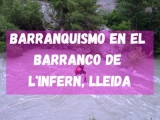What materials do you need to do canyoning? If you don't know exactly what you are going to use, we leave you with an article with the materials for canyoning.Learn a little more about the 5 canyons for go canyoning in the principality of Asturias:
canyoning in Asturias
1. Cares Ravine
This river originates in Posada de Valdeón (Picos de Europa-Leonesa Side). It has a length of 54 kilometers and has its origin in the waters of several streams that fall into a common channel at 1600 meters of altitude. The waters flow through the province of León and Asturias and flow into the Deva River.

The ravines that form in this river are the La Molina ravine that forms in the Casaño River and the Rubo ravine that forms in the bed of the Rubó River, which is a tributary of the Cares.
2. Hoz del Rubó Ravine
The Hoz del Rubó is a ravine located in Trescares, Asturias. It is a very complete beginner level canyon, although it is also accessible to the most experts.
It has three sections in which the most common is the middle section.The estimated time to complete the route is approximately 2-3 hours. It is a level I canyon ideal for families with children.

It has jumps, rappels and slides that make this ravine a real adventure. One of the most important parts is the so-called "Giant's Eye", an oval pool located between two large rocks that usually has a surprising emerald green color.
3. El Vallegón Barranco
The El Vallegón ravine is located in the basin of the Sella River, right next to the Picos de Europa National Park. It is in Amieva, 30 kilometers from Arriondas.
The ravine is divided into two sections, the lower and the upper. It has all kinds of rappels, slides, jumping into pools... It has everything!

The time to descend the ravine is 1 hour and a half or 2 hours depending on the number of people in the boat and the level of practice that the participants have.
The best time to do the ravine is between the months of March to November, always taking into account the flow.
4. La Molina Ravine
The ravine is located in Cabrales. This ravine is formed in the Casaño River, coming from the Picos de Europa National Park. They are 700 meters long and divided into two sections. It's short and simple; with straits, caves, aquatic labyrinths and jumps into the water.

It is suitable for all types of people since it has a low difficulty. The total duration of the activity is 3-4 hours and it is suitable for children from 12 years old.
5. Carangas Ravine
This ravine is located in the basin of the Ponga River, a tributary of the Sella, and in the Ponga Natural Park. It is in the town of Carangas, 35 kilometers from Arriondas.
The estimated time to descend the ravine is 1 hour or 1 and a half hours for the upper section. The best time to do the canyon is between the months of March to November.

The Carangas ravine has descents, rappels, slides, poles, jumps into pools... and consists of two sections:
• Upper section: it has 4 rappels and the level of difficulty is medium-low.
• Lower section: it has 22 rappels, two of them 40 meters, and its level of difficulty is high.












